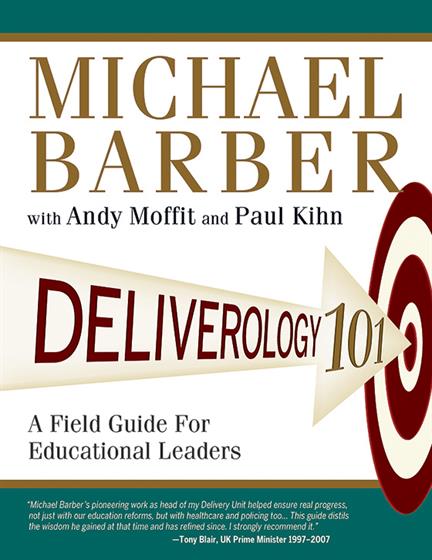Description
"Michael Barber outlines the steps that will enable courageous education leaders around the country to execute their plans and bridge the gap between hope and reality."
—Joel Klein, Chancellor
New York City Department of Education
"No one knows system reform better than Sir Michael Barber. His delivery contains bold, inspiring, crystal clear ideas that are never more timely than today. A must-read for reformers at all levels of the system."
—Michael Fullan, Professor Emeritus
University of Toronto Ontario Institute for Studies in Education
A step-by-step approach to delivering results
Michael Barber, former chief advisor on delivery to British Prime Minister Tony Blair, and his colleagues Andy Moffit and Paul Kihn thoroughly describe Barber's proven reform delivery processes in this practical field guide. The timing is ideal, as Barack Obama's administration prioritizes education reform. Citing education reform case studies from more than 20 countries, the authors assert that most previous reforms were unsuccessful due to failed implementation. This book focuses on how to accomplish meaningful results, including:
- Significant and ongoing education reform
- Excellence and equity across public education
- Students who are prepared to lead America's future
The authors illustrate a field-tested program that ensures reform is achieved in the most profound sense, with students able to see, feel, and reap the benefits of a high-quality education.
Listen as Barber describes the importance of the book:
Key features
Deliverology 101 has been written specifically for leaders of American education reform. It draws heavily on Instruction to Deliver and freely quotes from it; but instead of telling the story, it describes the routines, techniques and approaches in the form of a "field guide." Moreover, it is based not only on the experience of the Blair administration but also on case studies of successful implementation of reform in the U.S. and elsewhere. Much of what is described in the book has been piloted in collaboration with state K-12 and major education systems here in the U.S. and honed and refined as a result.
has been written specifically for leaders of American education reform. It draws heavily on Instruction to Deliver and freely quotes from it; but instead of telling the story, it describes the routines, techniques and approaches in the form of a "field guide." Moreover, it is based not only on the experience of the Blair administration but also on case studies of successful implementation of reform in the U.S. and elsewhere. Much of what is described in the book has been piloted in collaboration with state K-12 and major education systems here in the U.S. and honed and refined as a result.
The American education leaders I know are ambitious for their students; they know that a remarkable opportunity to transform public education is before them; they know what to do; and they know that a major barrier to seizing that opportunity is a severe lack of capacity to deliver. Deliverology 101 is prepared precisely to address these circumstances.
What does adopting an end-to-end "deliverology" approach in your system entail?
1. Develop a foundation for delivery. Every strong delivery effort has a few prerequisites that must be put in place before you begin: a clear idea of what the system should deliver, an understanding of where and how delivery must improve, a talented team to run the delivery effort on your behalf, and sufficient alignment at the top to get things done. As system leader, you will kick off the delivery effort by putting these in place.
2. Understand the delivery challenge. Knowing the nature of the problem you face will be crucial to success. With your foundation in place, your Delivery Unit will begin its work with a diagnosis of both the size and nature of the barriers that your system faces to delivery of your aspiration.
3. Plan for delivery. You have defined where you want to be, and you have learned where you are. The next logical question is, "How are we going to get there?" With the facts about performance in hand, your Delivery Unit will support you to define your system's approach to addressing the delivery challenge, to set a concrete and measurable definition of success, and to produce plans that will help your system to get there.
4. Drive delivery. Your system's strategy, targets, trajectories, and plans all represent commitments made by your system which, if honored, should generate real results. Your Delivery Unit's role will be to track progress against these commitments, to identify challenges and change course where required, and above all to push your system to keep its promises.
5. Create an irreversible delivery culture. The tools and tactics of delivery are necessary elements for success but they cannot ensure it will be achieved. Change will be irreversible only when you have succeeded in changing your system's culture, widening the circle of your delivery effort's leadership to include senior leaders, middle managers, the front line, and even the public. Therefore, you and your Delivery Unit will underpin every activity in your effort, as described in chapters 1-4, with efforts to build the skills and mindsets, send the messages, and develop the relationships that are instrumental to creating a culture of delivery.





